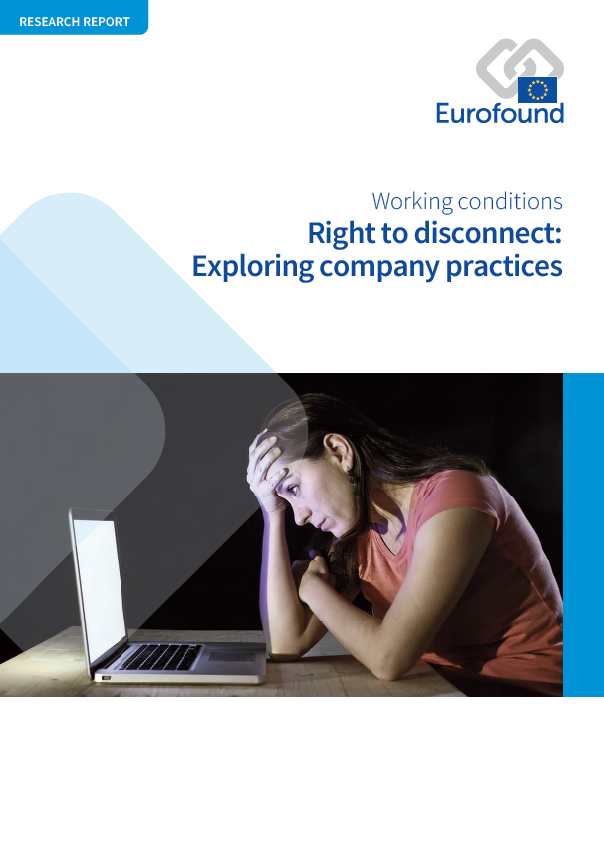
Digitale technologieën hebben het voor veel werknemers mogelijk gemaakt hun werk overal en op ieder moment te doen, en dat heeft voor- en nadelen. Uit gegevens van Eurofound blijkt dat telewerkers twee keer zo vaak de grens van 48 uur werktijd overschrijden, onvoldoende rust nemen en werken in hun vrije tijd, en dat heeft gevolgen voor hun lichamelijke en geestelijke gezondheid. Om dit probleem aan te pakken gaan er stemmen op voor het “recht om offline te zijn”. Dit verslag is gebaseerd op casestudy’s die de implementatie en het effect van het recht om offline te zijn op werkplekniveau in kaart brengen. Het bouwt voort op eerder onderzoek van Eurofound, waaruit blijkt dat het aantal collectieve arbeidsovereenkomsten waarin het recht om offline te zijn is opgenomen, toeneemt in landen waar dit recht in de nationale wetgeving is vastgelegd. Vanwege de exponentiële toename van telewerken door de COVID-19-pandemie is het belang van een betere balans tussen de kansen en uitdagingen die samenhangen met telewerken en met flexibele arbeid met behulp van ICT relevanter dan ooit tevoren.
Key findings
Home-based teleworkers are twice as likely to exceed the 48-hour working time limit as workers onsite and are significantly more likely to work in their free time. Following the shift to telework during the pandemic, this is likely to lead to more hybrid working arrangements in the future, putting the spotlight on whether existing labour legislation is fit for purpose.
The experience of the first four Member States that have introduced rules and agreements on the right to disconnect prior to 2021 has demonstrated the pivotal role of the social partners in ensuring these rules are translated into reality on the ground. In countries with weaker industrial relations, legislation can provide a fallback option to ensure minimum standards are met.
The introduction of the right to disconnect in companies has revealed that a ‘soft’ approach through awareness raising, training and the management of out of hours connection is more common than a ‘hard disconnection’, which severs access to company communication during specific times.
New agreements and texts addressing the right to disconnect will need to consider the issues that lead to the ‘perceived’ need for constant connection, such as workload, lack of training and work processes that feed overconnection. High-level buy-in and regular reinforcement of the message on the importance of the right to disconnect will be critical for its success.
Although evidence of the impact of the right to disconnect on employee health and well-being, work–life balance, gender equality and company performance is lacking, social partners’ experiences at company level suggest that positive changes in company culture are taking place following the introduction of the right to disconnect.
The report contains the following lists of tables and figures.
List of tables
Table 1: Main opportunities and risks of ICT-based mobile work for work and employment
Table 2: Reasons for an absence of debate on the right to disconnect, mid-2020
Table 3: Case study companies and dates of texts containing the right to disconnect
Table 4: Dates, titles, nature, signatories, scope and coverage of the texts analysed
Table 5: Modalities and key features of connection and disconnection
Table 6: Main approaches to monitoring used by case study companies
Table 7: Qualitative and quantitative evidence gathered on implementation and impact of the right to disconnect
List of figures
Figure 1: Teleworking during the pandemic, July 2020 (%)
Figure 2: Share of employees in different ICT-based flexible arrangements working in their free time daily or weekly, 2015 (%)
Figure 3: Experience of teleworking and working hours during the COVID-19 pandemic, July 2020 (%)
Figure 4: Share of emails received outside of regular working hours that were addressed immediately (%)
Figure 5: Preferences regarding telework post pandemic by teleworking status, July 2020 (%)
Figure 6: Right to disconnect and status of legislation and debate in EU Member States, mid-2021
Figure 7: Key elements of hard and soft approaches to disconnection
- Number of pages
-
70
- Reference nº
-
EF21049
- ISBN
-
978-92-897-2186-8
- Catalogue nº
-
TJ-05-21-238-EN-N
- DOI
-
10.2806/748556
- Permalink
Cite this publication
Eurofound (2021), Right to disconnect: Exploring company practices, Publications Office of the European Union, Luxembourg.